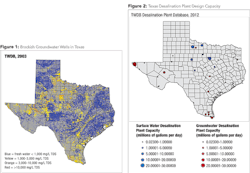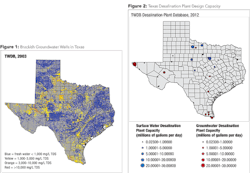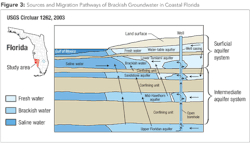Brackish Groundwater Supply: How RO Systems Can Meet Water Needs of Growing Populations
By Stefan Schuster
As surface water sources are being impacted by long-term drought conditions and fresh groundwater aquifers are being over-pumped, brackish groundwater is being considered as the next best available source in areas with a growing population.
Brackish groundwater -- which has more salinity than fresh water but not as much as seawater -- is known to underlie about 70 percent of the United States and is typically 1,000 to 10,000 ppm total dissolved solids. Most brackish water occurs in aquifers and coastal areas where fresh water meets saltwater.
One solution for turning brackish groundwater into potable water is to utilize Brackish Water Reverse Osmosis (BWRO) facilities, which can be developed and implemented relatively quickly and feature modular designs that allow for efficient upgrades over time. In addition, desalination technology can remove contaminants that traditional water treatment systems cannot.
BWRO facilities in Texas, California and Florida, for example, demonstrate how growing communities can benefit from brackish groundwater desalination strategies, if carefully planned, managed and integrated with the right design and treatment processes.
Texas
The abundance and distribution of brackish groundwater in almost all aquifers in Texas suggests approximately 2.7 billion acre-feet of water suitable for water production -- more than any other state (see Fig. 1).
In 2009, the Texas Water Development Board created the Brackish Resource Characterization System to map in greater detail where brackish groundwater occurs in the state's aquifers. The system also focused on building replicable numerical groundwater flow models to estimate aquifer productivity and developing parameter-screening tools to help assess the viability of brackish supplies.
Currently, Texas is exploring legislation to make brackish groundwater production preferential to fresh water while minimizing impacts on existing fresh groundwater.
Texas has 38 desalination plants -- using predominantly reverse osmosis (RO) membrane technology -- with a capacity of approximately 73 million gallons per day (MGD) of treated brackish groundwater. This is enough to supply water to half a million residents (see Fig. 2).
Florida
Brackish groundwater is found in the lower Floridan aquifer system. However, it is also present in the intermediate and surficial aquifer systems along coastal areas that have been impacted by lateral saline water intrusion, and in the Upper Floridan aquifer system in areas impacted by vertical saline water intrusion (see Fig. 3).
In Florida, there are 140 BWRO systems operating with a current permitted municipal use capacity of 551 MGD, which represents close to 25 percent of the total permitted capacity. Florida has five Water Management Districts (WMDs), which were formed in 1975 to manage the use of the state's water sources. WMDs have significantly restricted the use of fresh groundwater for agriculture, industry and municipal uses, and they have implemented rules that require the use of alternative water sources such as reclaimed, surface, brackish, and saline water.
California
Brackish groundwater in California occurs in both shallow coastal and deep aquifers throughout the state. As in Florida and Texas, coastal aquifers are influenced by seawater intrusion and accelerated by groundwater overdraft. The issue of contaminated groundwater -- particularly due to watershed-scale salt accumulation -- has been a key environmental driver of BWRO projects in Southern California.
California has 20 installed BWRO systems, with capacities ranging from 0.5 to 10 MGD each. State policymakers began to more seriously incorporate brackish water treatment as a water supply alternative in 2002, with the passage of both AB 2717 and Proposition 50. These acts established a California Desalination Task Force and provided funding for research as well as pilot-scale and full-scale projects.
Effective Treatment of Brackish Water
No matter the state or situation, a challenge with brackish groundwater use is the potential for the salinity to change over time. Over-stressing the target brackish groundwater zone can cause upward migration of higher salinity groundwater and impact treatment processes and energy consumption, which will affect the price of the produced water.
A critical factor for the successful operation of a BWRO system is the quality of the RO feedwater, which, in turn, is determined by the source water quality and the effectiveness of the pretreatment. The typical process train uses sand separation, chemical pretreatment, cartridge filtration, RO, degasification, disinfection, and corrosion control (see Fig. 4). Pretreatment chemicals are used to manage scaling in the RO membranes and reduce the pH to optimize hydrogen sulfide stripping in the degasifiers. Post-treatment chemicals are used to perform primary disinfection and to adjust the pH and alkalinity for corrosion control.
Pretreatment
Sand separators and cartridge filters are used to separate solid matter larger than a certain diameter (generally ≥0.1 mm) from source water that could plug, damage or foul the downstream RO or nanofiltration (NF) treatment systems.
As the RO/NF permeate passes through the membranes, the remaining concentrate becomes increasingly concentrated with dissolved solids. Scaling can reduce the flow or flux of permeate and can also damage the membrane itself, causing maintenance concerns.
Post-treatment
Degasifiers are typically used as post-treatment to remove gases from the RO/NF permeate by counter-current mass transfer of air and water. Degasifiers serve three important roles: 1) reduction of effluent turbidity by removing sulfide from the water stream before chlorination; 2) odor control for the treated effluent; and 3) corrosion control through the removal of excess CO2.
Depending on the downstream requirements, chemical addition may be required for pH adjustment, corrosion control and disinfection. In addition, innovations found during implementation include energy recovery and blending with existing supplies.
Concentrate Disposal
The other major design concern is the disposal of the RO concentrate. Common methods of disposal include surface water discharge (ocean outfall) and deep well injection, evaporation ponds, membrane distillation, and thermal treatment (although these latter methods are typically only applied when the need for zero-liquid discharge is required).
In Texas, the most common method for BWRO disposal is still surface discharge, while California and Florida use deep well disposal. As the use of brackish and deep groundwater continues, contamination from disposal wells could become a problem.
Current and Future Opportunities
There's a tremendous opportunity for brackish groundwater systems to help meet the water needs of growing populations in Texas, California and Florida. Hydrogeologic and engineering components of a brackish groundwater desalination strategy are not mutually exclusive and will require coordinated planning to achieve the best results. Source water availability and production, raw water quality, pretreatment needs, RO treatment, concentrate disposal, and plant design are all interrelated and should be considered simultaneously throughout project conceptualization and design.
It is clear that there is a sufficient quantity of brackish groundwater of suitable chemical quality to meet future water needs, especially in Texas, California and Florida. However, what remains unknown is the availability of the brackish groundwater resources at the local point of need and how to best manage groundwater as an integrated system. These concepts will be further defined and tested as more BWRO systems are implemented across the U.S.
About the Author: Stefan Schuster is the Texas Water Resources Strategy leader for MWH Global, with 25 years of professional experience in the water resources industry. He has extensive experience as a hydrologist and water resource planner working on diverse water resource planning projects throughout the state. During his career, Schuster has been a lecturer at the University of Texas, Austin, where he taught graduate water resources planning courses. He is a licensed professional geoscientist in Austin, Texas.
More WaterWorld Current Issue Articles
More WaterWorld Archives Issue Articles



